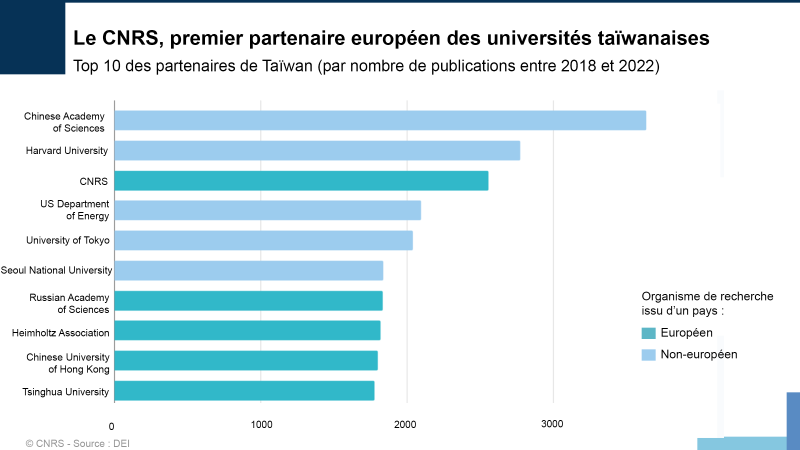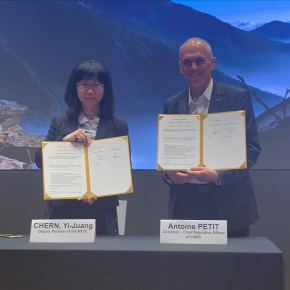
The CNRS and Taiwan – thirty years of scientific collaboration
An international conference was held on September 18th 2023 to mark the thirtieth anniversary of the first framework agreement between the CNRS and Taiwan's National Science & Technology Council. This was an opportunity to highlight the rich variety of Franco-Taiwanese research over the past three decades.
What do marine biology, medical robotics research and the study of the first European maps of Asia have in common? All these disciplines are the subjects of international collaboration projects involving CNRS scientists and Taiwanese universities. These historic relationships were put in the spotlight during a conference jointly organised on September 18th 2023 at CNRS headquarters by the CNRS and Taiwan's National Science & Technology Council (NSTC). The NSTC is the Taiwanese equivalent of a Ministry of Research and Technology on the island. The conference paid tribute to the first framework agreement being signed by the CNRS and the NSTC almost thirty years earlier in 1992. This event ended with the agreement being renewed for the fifth time and signed by Antoine Petit, the CNRS Chairman and CEO, and Yi-Juang Chern, the Vice-Minister of the NSTC.
Thirty years of rich scientific exchanges
In her closing speech, Yi-Juang Chern looked back on three decades of collaboration with the CNRS which she "thanked for its long-standing support". She expressed her hope that her institution "will continue to work with the CNRS for many years to come". These comments were well-founded as the CNRS and the different Taiwanese universities led by the National Taiwan University and the National Yang Ming Chiao Tung University are collaborating on a number of ongoing structuring initiatives. For example, the CNRS has a branch in Taipei of the French Centre for Research on Contemporary China, a joint unit of French research institutes abroad1, three international research projects, two international research networks and four international emerging actions. These initiatives have helped make the CNRS the third most important scientific partner of Taiwanese universities currently. The organisation is also Taiwan's leading European partner as demonstrated by the 2500 co-publications between the CNRS and local universities between 2018 and 2022.

Un tel appareillage institutionnel donne le jour à une grande richesse au sein des thématiques scientifiques, mise en avant par le colloque, où étaient représentés presque tous les instituts du CNRS. Comme le souligne Antoine Petit, « ce colloque illustre la variété des projets de recherche entre la France et Taïwan, particulièrement au niveau du CNRS, et leur dialogue régulier ». Même si la physique des particules et l’astronomie dominent actuellement les échanges scientifiques franco-taïwanais, le PDG du CNRS, fort du caractère pluridisciplinaire de l’organisme, envisage que de « nouveaux sujets émergent entre de nouvelles disciplines ».
Mobilités entre France et Taïwan
Outre ces points d’ancrage institutionnels, de nombreux échanges de personnels ont lieu entre la France et l’archipel taïwanais. Côté CNRS, on compte environ 200 missions par an à Taïwan, avec une répartition assez équilibrée pour chaque institut, tandis qu’on dénombre 29 doctorants et 11 post-doctorants taïwanais dans les unités CNRS en 2022. Parmi ceux-ci, Ping-Jui Yu suivait jusqu’en 2022 des études de chimie à la National Taïwan University (NTU), sous la supervision de Wen-Chang Chen, par ailleurs président de ladite université. Ping-Jui Yu le reconnaît sans ambages : « Je ne connaissais pas le CNRS avant de venir en France ». Et, pourtant, il découvrit l’organisme français grâce au projet de recherche auquel collaborait son directeur de thèse aux côtés du Français Redouane Borsali. Ce dernier, directeur de recherche au sein du Centre de recherches sur les macromolécules végétales à Grenoble1 , coordonne le Green Material Institute2 avec la NTU et convainquit Wen-Chang Chen, avec qui il travaillait depuis près de dix ans sur des copolymères à base de sucre pour remplacer les dérivés du pétrole dans l’industrie électronique, recherches pour lesquelles ils ont tous deux reçu le prix de la Fondation scientifique franco-taiwanaise 2018 remis par le NSTC, d’offrir en 2022 un contrat doctoral NTU et CNRS à Ping-Jui Yu de manière à le faire venir en France. Enthousiaste, Ping-Jui Yu se montre désormais exalté par « les matériaux utilisés et la manière de faire de la synthèse chimique en France ».
En plus du recrutement d’un doctorant, Redouane Borsali a pu de son côté bénéficier, grâce au Green Material Institute dont il est coordinateur, d’un accès privilégié aux industries électroniques de Hsinchu, « la Silicon Valley taïwanaise », où se concentrent industries de pointe, universités et instituts scientifiques et technologiques. À ses yeux, « Green Material Institute m’a permis d’aller vers les industriels taïwanais – comme Industrial Technology Research Institute et Taiwan Semiconductor Manufacturing Company – mais aussi japonais, tels Toshiba, Hitachi et Tokyo Electron ».
De telles collaborations pourraient être amenées à durer, sinon à se multiplier, au vu du cinquième renouvellement de l’accord-cadre entre le CNRS et le NSTC. Étant donné la qualité et de l’ancienneté de cette relation, Antoine Petit dit espérer, en signant le document, « renouveler nos coopérations pour les trente prochaines années ». À tout le moins, celles-ci seront renforcées par des accords spécifiques entre des établissements d’enseignement supérieur et de recherche et le CNRS : après l’Academia Sinica en 2018, c’est au tour de la NTU d’en signer un avec l’organisme français en octobre prochain. Une cérémonie de signature est prévue le 13 octobre, au cours de laquelle le président-directeur général du CNRS accueillera le président de la NTU et une délégation taïwanaise.


